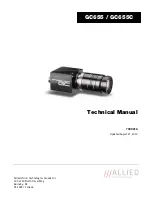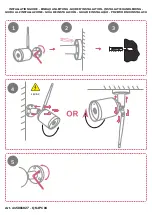
GC655Technical Manual
Page 7
Sync Input 1 and Sync Input 2
These input signals allow the camera to be synchronized to some external event. The camera can
be programmed to trigger on the rising edge, falling edge, both edges or level of this signal. The
camera can also be programmed to capture an image at some programmable delay time after the
trigger event.
Sync Input 1 is isolated and should be used in noisy environments to prevent false triggering due
to ground loop noise. Sync Input 2 is non-isolated and can be used when a faster trigger is
required and when environmental noise is not a problem.
Sync Output 1 and Sync Output 2
These signals only function as outputs and can be configured as follows:
Exposing
Corresponds to when camera is
integrating light.
Trigger Ready
Indicates when the camera will accept a
trigger signal.
Trigger Input
A relay of the trigger input signal used to
“daisy chain” the trigger signal for
multiple cameras.
Readout
Valid when camera is reading out data.
Imaging
Valid when camera is exposing or reading
out.
Strobe
Programmable pulse based on one of the
above events.
GPO
User programmable binary output.
Any of the above signals can be set for active high or active low.
Sync Output 1 will require a pull up resistor of greater than 1Kohm to the user’s 5V logic supply.
Sync Output 1 is isolated and should be used in noisy environments. Sync Output 2 is non-isolated
and can be used when environmental noise is not a problem and when faster response is required.
RS-232 RXD and RS-232 TXD
These signals are RS-232 compatible. These signals allow communication from the host system via
the Ethernet port to a peripheral device connected to the camera. Note that these signals are not
isolated and therefore careful attention should be used when designing cabling in noisy
environments.












































